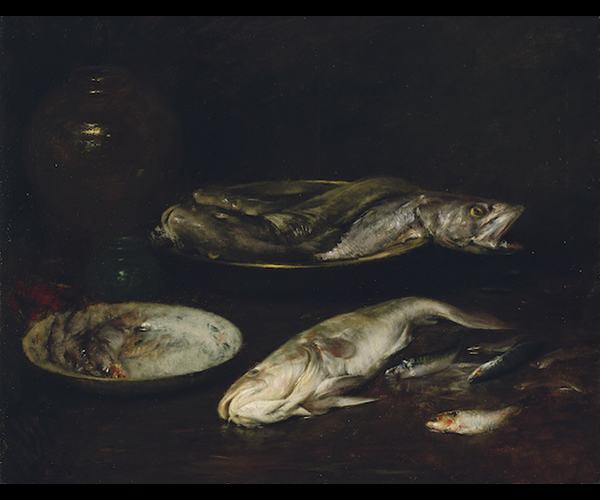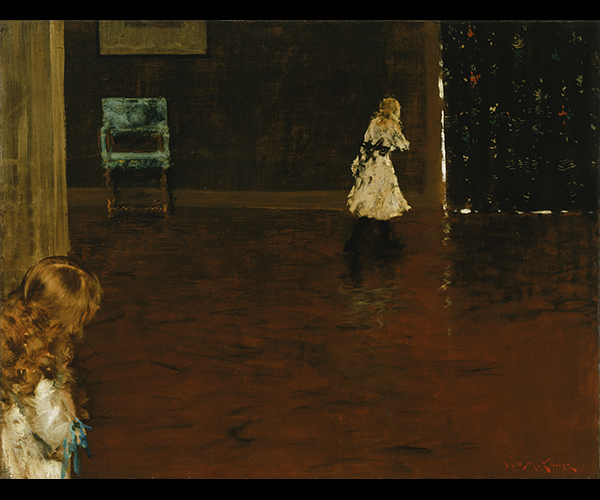Visual Arts Review: More than a Painter of Fish — William Merritt Chase at the MFA
The variety of this exhibition amply proves that William Merritt Chase brought great painterly insight to much more than just the daily catch.
William Merritt Chase, jointly organized by the Museum of Fine Arts, Boston, the Phillips Collection, the Terra Foundation, and Fondazione Musei Civici di Venezia. At the Museum of Fine Arts, Boston, through January 16, 2017.

Still Life — Fish, around 1900, William Merritt Chase. Photo: courtesy of the Museum of Fine Arts, Boston
By Kathleen Stone
Legend has it that painter William Merritt Chase, while demonstrating technique to students, would wear an elegant suit — and never dripped a spot of paint on his crisp white shirt. He could paint a picture of a fish with strokes so sure and quick he would return the catch to the market before it had become warm. Apocryphal, perhaps, but these yarns testify to his impressive skill — and the high regard in which his students held him.
This lovely show of William Merritt Chase’s work is arranged thematically, the rooms roughly corresponding to the years he was active, from the mid-1870s to 1916. Work from his student days in Munich fill one room, figurative and still life paintings that pay loving homage to Old Masters, Van Dyck, Rubens, and Hals among them. That he chose Munich as the place to study, rather than Paris, showed early on that he would follow his own path. It may also have reflected his upbringing in the Midwest, where many German immigrants settled.
In 1878, Chase rented a studio on Tenth Street in New York. Into it he crammed porcelains, lamps, parasols, pots, fabrics, and paintings from around the world. The pictures this self-consciously theatrical environment inspired is grouped in another section of the MFA exhibit. May I Come In? gives us a woman peaking around the door into Chase’s studio: the color, volume, and texture of various objects displayed in the corner are expertly rendered. The message is about than just the eye-catching props; the assemblage generates cosmopolitan energy, conveying the calculated impression that Chase is a man of the world. The woman in the picture is his wife, and though we see only her face and part of her coat, she is fresh and charismatic, a sign that Chase was interested in depicting women of an independent spirit.
In another portrait, Chase captures a female colleague in a pose traditionally reserved for men, hand on hip and head turned toward the viewer. But, ironically, a gorgeous pink ribbon streams down her back. He is tweaking tradition in order to honor her, a ‘new’ woman. Chase was professionally acquainted with the acclaimed writer Edith Wharton, herself a woman of enormous independence. They both grappled in their art with the confining roles consigned to women at the tail end of the Gilded Age. Wharton’s observations are sharper and clamor for change; Chase is comfortable sitting at the cusp of social and artistic evolution.
As a painter, Chase was experimental but not revolutionary. Pastel was one of the mediums, for instance, where he experimented and exceled. Some of the works are large, nearly four feet square, and are testaments to his prowess in working with a tricky medium. For the most part they avoid — through acidic color and off center design — the treacly sweetness that pastels can fall prey to. They also show the effect of working outdoors, as Chase did in the city and at the Shinnecock summer art school on Long Island: fresh air and sunshine lightened his palette and provided material for outdoor scenes. The End of the Season is a tour de force of line, with rungs of chairs, pushed up against abandoned seaside tables, crisscrossing the paper.
Like many artists of the time, Chase was fascinated with non-European artifacts. From the mid-nineteenth century on, Japanese objects flowed steadily to Europe and the United States, and Chase purchased screens, kimonos, fans, and large pots for his studio. In A Comfortable Corner, the model’s white petticoat and black stockings show beneath an intricate floral kimono. Today, dressing an American woman in traditional clothing of an ‘exotic’ culture would be perceived as a risky move. But politics were different then, and Chase felt free to pursue the artistic challenges offered by juxtaposing unfamiliar objects with familiar artistic conventions. For instance, the model sits in front of a Japanese landscape screen and a roundly sculpted object – a background both flat and full of volume. She props her arms on plump pillows and rests her feet on a woven rug. Chase masters the multiple patterns of kimono, screen, pillows and rug, each distinct but none overwhelming the others. The complex depths of field in the picture are even more challenging. The screen behind the woman is flat, but its landscape scene appears to have volume. She sits on a plush velvet couch surrounded by squishy pillows, yet holds a bamboo fan so flat it lacks any depth at all. The fact that Chase constructed such a scene on a flat canvas, capturing such widely varying depths and volumes, proves that he had a hearty appetite for challenge.

“Hide and Seek,” 1888, William Merritt Chase. Photo: Courtesy of the Museum of Fine Arts, Boston.
In Hide and Seek he again toys with composition. Two young girls are at play, their white dresses and a sliver of light from the door the only illumination in the chocolate brown room. He angles the girls onto opposing sides of the canvas — leaving the center empty – and has the floor tilt up to meet the wall. Here Chase is playing with picture plane, as many of his contemporaries did, but without entirely abandoning the convention of a three-dimensional room.
In Chase’s work, many of the innovations that would transform twentieth century painting can be seen in embryonic form. More than a few of his students – Charles Sheeler, Georgia O’Keefe, Marsden Hartley, and Charles Demuth, for example – became noted modernists. But Chase himself never left realism behind, even though he experimented with contemporary ideas.
He often returned to the motif of piscine still life, painting a fish’s silvery flesh rippling over a plate. (You want to run your hand over the fish before flipping it on the grill.) Chase worried that he would be remembered only as “a painter of fish, a painter of fish.” But the variety of this exhibition amply proves that he brought great painterly insight to much more than just the daily catch.
Kathleen Stone lives in Boston and writes critical reviews for The Arts Fuse. She co-hosts a literary salon known as Booklab and is at work on several long projects. She holds graduate degrees from the Bennington Writing Seminars and Boston University School of Law, and her blog can be found here.
Tagged: American Painter, Kathleen Stone, museum-of-fine-arts-boston
